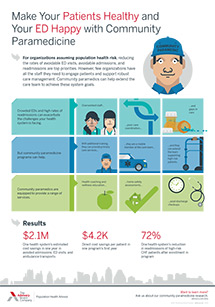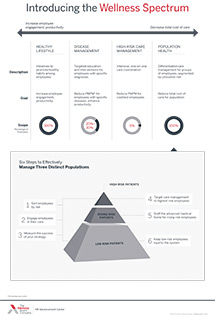Auto logout in seconds.
Continue LogoutFeeling confused by the jumble of terms on your food labels, from "organic" to "superfood" to "GMO?" Here are the terms you can safely ignore—and the ones that experts say actually matter, Lizz Schumer writes for the New York Times.
Help your employees promote healthy habits—regardless of the newest diet fads
A dictionary of confusing food terms
According to Liz Vaknin of the food marketing company Our Name Is Farm, many common food label terms are simply designed to get you to buy the product. "The more value you ascribe to a term, the more you identify with it, the more you're willing to pay for it," she said. "Some are useful, some are misleading, and a lot of them are not regulated enough to mean anything."
Schumer provides a rundown of potentially confusing terms:
- "Natural" is a term you can mostly ignore, Vaknin said, noting the term "natural" is used all the time, but it has almost no meaning.
- "Superfood" also is pretty much meaningless, according to Andy Bellatti, a registered dietitian and co-founder of Dietitians for Professional Integrity. "As I like to say, all plant-based foods are 'superfoods' in the sense that they offer fiber, vitamins, minerals, and phytonutrients," he said, adding, "A peach is just as 'super' as a berry that grows in the Himalayas."
- Genetically modified organism (GMO): Many people worry about GMO foods, Vankin said, "because they don't really know what [the term] means." Schumer explains that GMOs "can run the gamut from selecting spinach for frost resistance to adding nutrients to foods that don't produce those compounds in nature"—but the fact that a food has been genetically modified doesn't mean that it's bad for you. In fact, Schumer writes, the majority of scientists agree that GMO foods are perfectly safe. Still, if the idea of GMO foods scares you, Schumer recommends buying heirloom vegetables and heritage meat.
- "Organic" is another frequently misunderstood term, Schumer writes. Generally speaking, farmers who farm organically use compounds that occur naturally to keep away insects, as opposed to artificial pesticides. Animals raised for organic meat can't consume antibiotics or hormones. Debi Zvi, a clinical nutritionist at NewYork-Presbyterian Hospital, explained that products that are certified organic by the United States Department of Agriculture (USDA) must meet "a set of publicly available standards," and farms must go through a long, thorough application and certification process that typically takes about five years to finish, Schumer writes. But are organic foods actually any healthier or safer? According to Vaknin, it depends on how susceptible a plant is to its growing environment. Nonorganic bananas, for example, "are probably fine because you're going to be peeling them, but with strawberries, those pesticides are going to be absorbed directly into the fruit," she said. "So if you can't afford to buy all organic, pick and choose."
- Whole vs. processed foods also have different meanings—but it doesn't always matter, Schumer writes. According to Bellatti, whole or minimally processed foods are generally better for you, especially for plant-based foods, as "processing greatly reduces fiber as well as minerals like potassium and vitamins like vitamin C." That being said, foods defined as "processed foods" by the USDA can include healthy items such as frozen vegetables, dried fruit, and canned beans, alongside more problematic foods like candy and soda, Schumer writes.
So what actually matters?
While plenty of terms on a food label are confusing, unimportant, or unregulated, some aspects of the food label really do matter, according to Schumer.
Nutrition facts
You should definitely pay attention to the list of nutrition facts required by the FDA, Schumer writes. "A healthful food is low in added sugar, low in added sodium, and offers a nice amount of fiber," Bellatti said. Bellatti recommends consuming no more than 24 grams of added sugar per day.
Zvi recommended that consumers who are on the go select "foods with less than 20% daily value of sodium and saturated fat, and less than 10 grams of added sugar."
You should also pay close attention to serving sizes on the nutrition facts label, Zvi said, noting that foods marketed as "single-serving" can actually contain multiple servings.
Where you food comes from
Knowing how far your food has traveled to get to your grocery store is important as well, Schumer writes, as produce loses some of its health benefits after harvest. According to Alina Zolotareva, a registered dietitian and marketing manager of AeroFarms, "The second you harvest, [produce] starts losing vitamin C and phytochemicals that are sensitive to oxygen."
As such, Schumer writes, it's good to buy locally-grown produce. Local farmers also can tell you exactly how their food is grown, when it was harvested, and what's in season.
What you'll actually eat
Ultimately, it's most important to buy food that "you and your family [are] realistically going to eat," Zolotareva said. Vaknin added, "As a country, we're willing to spend money on a lot of things, and the one thing we compromise on is food."
That's not a compromise we should make, Schumer writes. "[I]f you're able to spend less on your next pair of shoes and a little more on feeding yourself and your family the most healthy options, it may be worth giving your grocery budget a little boost" (Schumer, New York Times, 7/3).
Help your employees promote healthy habits—regardless of the newest diet fads
Programs aimed at promoting healthy habits among employees are likely to lead to improved employee engagement and productivity—but they're unlikely to reduce the total cost of care. To do that, you'll need to take a population health approach.
Don't miss out on the latest Advisory Board insights
Create your free account to access 1 resource, including the latest research and webinars.
Want access without creating an account?
You have 1 free members-only resource remaining this month.
1 free members-only resources remaining
1 free members-only resources remaining
You've reached your limit of free insights
Become a member to access all of Advisory Board's resources, events, and experts
Never miss out on the latest innovative health care content tailored to you.
Benefits include:
You've reached your limit of free insights
Become a member to access all of Advisory Board's resources, events, and experts
Never miss out on the latest innovative health care content tailored to you.
Benefits include:
This content is available through your Curated Research partnership with Advisory Board. Click on ‘view this resource’ to read the full piece
Email ask@advisory.com to learn more
Click on ‘Become a Member’ to learn about the benefits of a Full-Access partnership with Advisory Board
Never miss out on the latest innovative health care content tailored to you.
Benefits Include:
This is for members only. Learn more.
Click on ‘Become a Member’ to learn about the benefits of a Full-Access partnership with Advisory Board
Never miss out on the latest innovative health care content tailored to you.


